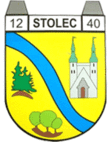Stolec (Ząbkowice Śląskie)
| Stolec | ||
|---|---|---|

|
|
|
| Basic data | ||
| State : | Poland | |
| Voivodeship : | Lower Silesia | |
| Powiat : | Ząbkowice Śląskie | |
| Gmina : | Ząbkowice Śląskie | |
| Geographic location : | 50 ° 36 ′ N , 16 ° 53 ′ E | |
| Residents : | ||
| Postal code : | 57-200 | |
| Telephone code : | (+48) 74 | |
| License plate : | DZA | |
| Economy and Transport | ||
| Street : | Ząbkowice Śląskie - Ziębice | |
Stolec ( German pride ) is a village in the powiat Ząbkowicki ( Frankenstein district ) in the Lower Silesian Voivodeship in Poland . It belongs to the urban and rural municipality Ząbkowice Śląskie ( Frankenstein ) and is located on the voivodship road 385, which leads to Ziębice ( Münsterberg ).
Geographical location
The village is located in Lower Silesia , five kilometers east of Ząbkowice Śląskie. Neighboring towns are Sieroszów ( Seitendorf ) and Rososznica ( Olbersdorf ) in the northeast, Niedżwiednik ( Bärwalde ) to the east, Starczów the southeast, Goleniów ( Gallenau ) and Kamieniec Ząbkowicki in the south, Strąkowo ( Kunz village ) in the southwest and Jaworek ( Heinersdorf ) and Bobolice ( Schräbsdorf ) in the Northeast.
history
Stolz, whose church was first mentioned in 1251, was part of the Duchy of Wroclaw at the time . On April 24, 1277, a battle took place between Stolz and Protzan , in which the Wroclaw Army fought against Duke Boleslaus II of Liegnitz , who held his nephew, Duke Heinrich IV of Wroclaw , imprisoned at Lähnhaus Castle because of inheritance disputes . Through the mediation of the Bohemian King Ottokar II Přemysl , an armistice was reached on July 13, 1277.
From 1278 Stolz belonged to the Duchy of Schweidnitz and from 1331 to the newly founded Duchy of Münsterberg . Together with this it came under Bohemian feudal sovereignty in 1336, which Duke Bolko II recognized in the Treaty of Straubing in the same year.
After the First Silesian War , Prussia fell to Prussia in 1742 . After the reorganization of Prussia, it belonged to the province of Silesia from 1815 and from 1818 was incorporated into the district of Frankenstein , with which it remained connected until 1945. Since 1874, the rural communities of Kunzendorf, Reisezagel and Stolz and the Stolz estate have formed the Stolz district . In 1939 it consisted of 1309 inhabitants.
After the end of World War II , Stolz was placed under Polish administration by the Soviet occupying forces in the summer of 1945 . The Poles introduced the place name Stolec for pride . The German population was driven out of pride by the local Polish administrative authority . The newly settled residents came mainly from areas east of the Curzon Line , as part of Poland's shift to the west . Their areas of origin in what was formerly Eastern Poland were conquered by Poland in the Polish-Soviet War (1919–1921), fell to the Soviet Union with the Soviet occupation in 1939, were occupied by the Germans during the German invasion of the Soviet Union in 1941 and returned after the Second World War The Soviet Union.
Attractions
- The church of St. Maria and Susanna, first mentioned in 1251, was expanded in the second half of the 16th century in the Renaissance style and changed to Baroque style in the 18th century. At the end of the 19th century it was given a neo-Gothic vestibule. The triptych of St. The clan in the main altar dates from the beginning of the 16th century, several stone epitaphs from the beginning of the 17th century. In the years 1536 to 1653 and between 1707 and 1945 the church served as a Protestant church.
- The branch church of St. John of Nepomuk was built from 1909 to 1911 in neo-Gothic style. Landeck sculptor Aloys Schmidt created the main altar .
- Stolz Castle was built for Heinrich Graf von Churschwandt in the first half of the 18th century and rebuilt for Ludwig Wilhelm von Schlabrendorf from 1773 to 1779 . Another renovation took place in the last quarter of the 19th century. After the Second World War it was left to decay. In the remains of the wall there are paintings with plant motifs, among other things.
- The manor house was built in 1607 for Franz von Burghaus and rebuilt in 1730 for Heinrich Graf von Churschwandt. In the second half of the 19th century a shed was added.
literature
- Dehio -Manual of Art Monuments in Poland Silesia . Munich · Berlin 2005, ISBN 3-422-03109-X , pp. 873-874
- Historical Commission for Silesia (Ed.): Geschichte Schlesiens , Vol. 1, Sigmaringen 1988, ISBN 3-7995-6341-5 , p. 121.
Web links
Individual evidence
- ^ Michael Rademacher: German administrative history from the unification of the empire in 1871 to the reunification in 1990. frankenstein.html. (Online material for the dissertation, Osnabrück 2006).

